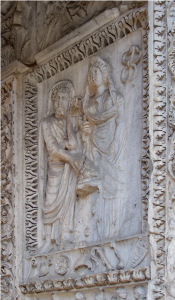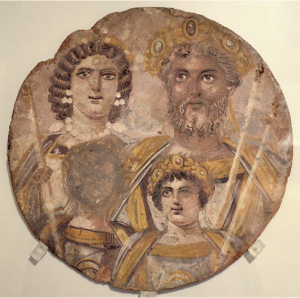Sons of Septimius Severus, Marcus Aurelius Antonius (Caracalla) and his younger brother Publius Septimius Geta (Geta) demonstrate how Damnatio Memoriae only augments a person’s presence despite the wish for them to be condemned. In 209 CE, Geta joined his father and brother with the title Caesar while his brother served as a joint emperor with his father. After his father’s death in 211CE, Geta was elevated to coemperor with Caracalla, resulting in the unveiling of a brutal rivalry between the two. While the public remained oblivious to this feud before, it escalated to the creation of separate military factions which threatened civil war and made it impossible to ignore. Caracalla took the matters into his own hands and had Geta assassinated before he could usurp Caracalla’s power.

Figure 4. Relief from the Arch of the Argentarii showing Geta’s family and a blank spot where it is assumed his image was perviously before it was scrubbed off (photo: Panairjdde, CC BY-SA 2.0)
Following the death of Geta, Caracalla pushed for a Damnatio Memoriae of his brother where it became a capital offense to acknowledge Geta’s existence. Geta’s image was immediately carved out of every relief and his name scrubbed from every inscription. The most notable pieces of evidence that exist today are the reliefs on the Arch of the Argentarii and a painted panel found in Egypt (Figure 4 and 5). Both the relief and the panel originally conveyed a family portrait of Geta, Caracalla, Septimius Severus, and his mother, Julia Domna. However, on both of these artifacts, Geta’s face had been scrubbed off as part of his condemnation.
The removal of Geta’s likeness from the relief and the panel neglect to completely erase his presence in the portraits. As a result of there being no effort to re-carve or repaint over the young boy, it is obvious to the audience that Geta existed. In fact, rather than only illustrating a mere forgetting, the image’s disfiguration is dramatic and conveys extremes emotion between the brothers. The images make it clear that Caracalla wanted the audience to know the power he held over his brother to do this practice. The lack of hiding what Damnatio Memoriae had done to the artifacts does not make the audience forget Geta at all, but rather makes them understand the brotherly feud on a deeper level since they can see Caracalla’s distain and anger in the mutilated image of Geta.

Figure 5. Panel found in Egypt depicting Geta, Caracalla, and their parents. Geta’s image has been removed but not painted over (Altes Museum, Staatliche Museen zu Berlin, photo: Carole Raddato, CC BY-SA 2.0)
Caracalla never intended to have Geta wiped from existence. While he might have removed anything that was linked to Geta specifically, the presence of the scrubbed off images and inscriptions constantly alludes to his existence. Rather than hiding his memory, he destroyed it and made it clear for all who witnesses. Considering the way Caracalla used Damnatio Memoriae, it is apparent that he didn’t want Geta to be forgotten, but rather for history to remember how Geta was dishonored by his condemnation. Caracalla left traces of Geta so people would know that he persevered in the brotherly rivalry.
It is evident that Damnatio Memoriae does not truly get rid of the memory of a person since the story of the two brothers is well studied today in the 21st century. Moreover, this practice of condemnation only increased the intrigue of Geta, bringing him to the forefront of Roman history and forever immortalizing his memory with this dishonor. This is just one of several examples of how Damnatio Memoriae was never intended to truly erase a person from history.
References
